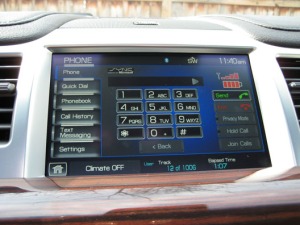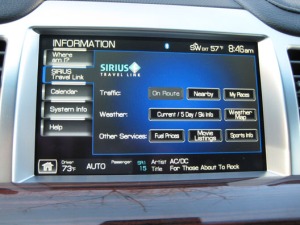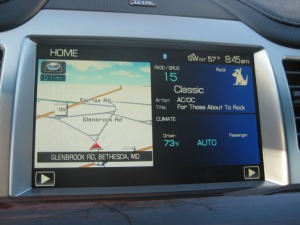To some, the names Ford and Microsoft make people cringe. Those of you who remember the Pinto, and more recently the Explorer/Firestone fiasco, may not trust Ford. Windows Vista was enough to give Apple an almost 10% market share in the world of personal computers. In the past few years though, Ford has spent a lot of time, money and energy in order to make its cars competitive with domestic and foreign rivals. One of the things they needed to accomplish was increasing the amount of technology in the vehicles they manufactured. Starting in 2008, Ford offered a technology called SYNC, which they developed in cooperation with Microsoft. SYNC is a voice-activated in-car communications system. It integrates into the radio, phone, climate control and optional navigation systems. It allows the driver to control most in-car features, which normally would require looking away from the road. After the jump, we’ll jump in and take a look at its features.
SYNC has a lot going on. It’s bundled with Bluetooth hands-free technology for your cell phone, the radio, navigation system (when equipped) and the climate control (when equipped with automatic climate control), as I mentioned before, but how does it accomplish each of those tasks? Ford adds buttons to the steering wheel, which when pushed, activate certain features of the system, mainly the voice activation features, volume and seek buttons. The big one of those three is the voice activation. For years, Microsoft has worked on voice recognition. Teamed up with an easy-to-use interface, the SYNC system uses your voice to command the system to change stations, system parameters, and set your destination. My own personal vehicle is a 2009 Lincoln MKS, which features the SYNC system and navigation. If you get a Ford product without the navigation system, some of the features will be unavailable or different, so keep that in mind. Ford provides a very detailed instruction manual for the SYNC system in each of its vehicles.
 The first thing you’ll want to do when you first get the SYNC system is to pair your cell phone. The SyncMyRide web site lists phones which have been tested to be compatible with SYNC. Pairing the phone is the only step you have to complete in order to activate the entire system. The built-in GPS will find out where you are, and the radio station will be set to its default station. The SYNC system in the Lincoln vehicles comes with Sirius radio. On other vehicles, it may be optional. The standard option packages on Ford vehicles will bundle the SYNC with Sirius radio and sometimes navigation as well.
The first thing you’ll want to do when you first get the SYNC system is to pair your cell phone. The SyncMyRide web site lists phones which have been tested to be compatible with SYNC. Pairing the phone is the only step you have to complete in order to activate the entire system. The built-in GPS will find out where you are, and the radio station will be set to its default station. The SYNC system in the Lincoln vehicles comes with Sirius radio. On other vehicles, it may be optional. The standard option packages on Ford vehicles will bundle the SYNC with Sirius radio and sometimes navigation as well.
Getting used to the SYNC system is quite easy, especially compared to competing systems in BMW and Mercedes-Benz vehicles. Theirs have gotten easier to use with each passing year, but they still don’t have the simplicity of SYNC’s user interface. The touch screen in Ford, Lincoln and Mercury vehicles is big, so it displays a lot of information, allowing you to view the navigation, radio and climate control overviews. Touching any of the three portions of the screen takes you to a more detailed display based on the selected subsystem. Only in rare instances does the SYNC system require you to push a physical button, so almost of the things you’ll want to do with SYNC can be done by touching the 8″ touch screen. The visual and aural feedback the system gives you lets you know that the system got your command. While driving, you can use the Voice button on the steering wheel to change stations, set your destination, among a littany of other commands SYNC is preprogrammed for, among commands you yourself can add. For instance, in the Address Book section of the navigation system, you can add “Voice Tags” to addresses you enter, which then allows you to set them as destinations via the Voice button.
 One of the most oft-mentioned features of SYNC is its ability to incorporate your USB device (specifically Apple’s iPod) into the audio system. To get your iPod to work with SYNC, all you have to do is plug your Apple-supplied dock connector into the provided USB port on the dash or in the center console, and then switch to the USB source in the Audio subsystem. SYNC will try to index all of your songs, and upon its completion, will allow you to play songs via name, artist, genre, or to play all songs on the USB device. This makes it far easier to find and play a particular song than has been found on similar systems, both stock and aftermarket, in past years. No longer will you spend minutes of your drive searching for a particular song, not to mention distracted from actually driving your car.
One of the most oft-mentioned features of SYNC is its ability to incorporate your USB device (specifically Apple’s iPod) into the audio system. To get your iPod to work with SYNC, all you have to do is plug your Apple-supplied dock connector into the provided USB port on the dash or in the center console, and then switch to the USB source in the Audio subsystem. SYNC will try to index all of your songs, and upon its completion, will allow you to play songs via name, artist, genre, or to play all songs on the USB device. This makes it far easier to find and play a particular song than has been found on similar systems, both stock and aftermarket, in past years. No longer will you spend minutes of your drive searching for a particular song, not to mention distracted from actually driving your car.
 When Sirius is activated with the navigation system, a feature called Sirius Travel Link is available, which gives you traffic updates on your selected route, and gives you the option to avoid them. In the case of accidents, the information may be old, in which case the traffic jam it warns you about could be cleared by the time you get to it. For road work and road closures, it’s best to avoid them when given the option, unless you are familiar with the area and know that the incident won’t affect your travels. There’s also a part of this travel link which illuminates highways in certain colors: blue for clear, yellow for moderate traffic and red for heavy traffic.
When Sirius is activated with the navigation system, a feature called Sirius Travel Link is available, which gives you traffic updates on your selected route, and gives you the option to avoid them. In the case of accidents, the information may be old, in which case the traffic jam it warns you about could be cleared by the time you get to it. For road work and road closures, it’s best to avoid them when given the option, unless you are familiar with the area and know that the incident won’t affect your travels. There’s also a part of this travel link which illuminates highways in certain colors: blue for clear, yellow for moderate traffic and red for heavy traffic.
 With Sirius satellite radio, SYNC doesn’t just let you select a station and listen. It actually gives you the ability to set a “Song Alert” (under the Memo option on the Audio display) which will then scan all the Sirius stations, and when you’re listening to Sirius, will pop up a message letting you know the particular song, what channel it’s about to play on, and give you a button to tune directly to it. When pushing the “Tune” button on this message, Sirius will tune to the channel the song is about to play on, about 5 seconds before the song starts to play. This is a great feature, because with over 100 channels on Sirius, it can be difficult to find a particular song you’d like to hear.
With Sirius satellite radio, SYNC doesn’t just let you select a station and listen. It actually gives you the ability to set a “Song Alert” (under the Memo option on the Audio display) which will then scan all the Sirius stations, and when you’re listening to Sirius, will pop up a message letting you know the particular song, what channel it’s about to play on, and give you a button to tune directly to it. When pushing the “Tune” button on this message, Sirius will tune to the channel the song is about to play on, about 5 seconds before the song starts to play. This is a great feature, because with over 100 channels on Sirius, it can be difficult to find a particular song you’d like to hear.
 SYNC also features some helpful features not directly related to standard in-car entertainment. These include 911 Assist, Vehicle Health Report, and Weather Link. The 911 Assist feature (standard on some 2010 models, dealer-installed for others) will use your Bluetooth phone to call 911 in the case of an accident where airbags are deployed. The Vehicle Health Report checks all of your car’s subsystems and emails them to you, viewable on the aforementioned SyncMyRide web site. It gives you an easy to view update on what’s going on with your car, along with dealership coupons (for the Ford, Lincoln or Mercury dealership of your choice). Lastly, Weather Link shows you the current weather for wherever you are, a 5-day forecast, and skiing information. It’s definitely useful for when you are traveling.
SYNC also features some helpful features not directly related to standard in-car entertainment. These include 911 Assist, Vehicle Health Report, and Weather Link. The 911 Assist feature (standard on some 2010 models, dealer-installed for others) will use your Bluetooth phone to call 911 in the case of an accident where airbags are deployed. The Vehicle Health Report checks all of your car’s subsystems and emails them to you, viewable on the aforementioned SyncMyRide web site. It gives you an easy to view update on what’s going on with your car, along with dealership coupons (for the Ford, Lincoln or Mercury dealership of your choice). Lastly, Weather Link shows you the current weather for wherever you are, a 5-day forecast, and skiing information. It’s definitely useful for when you are traveling.
So, with so many features combined with an easy-to-use interface, SYNC presents a communications center’s worth of information and abilities, from the weather to Sirius radio to up-to-the-minute traffic, not to mention regular AM/FM radio, CDs, and of course, navigation. It’s a great package, well thought out, and well engineered. In the several months I’ve been using it, not once has it crashed, and it just works, as I said in my Lincoln MKS review. The only complaint I’ve come up with is that you can’t disable the “ding” noise that the navigation system plays while giving you directions, without disabling the voice as well. Thankfully, you can control the voice prompt volume separately from the main audio volume, so you can turn it down. The navigation system lowers the main audio volume when it gives you voice prompts, so by lowering the voice prompt volume, you get a lack of audio volume, which is a good audio clue to look at the navigation screen to see your next turn.
By John Suit



